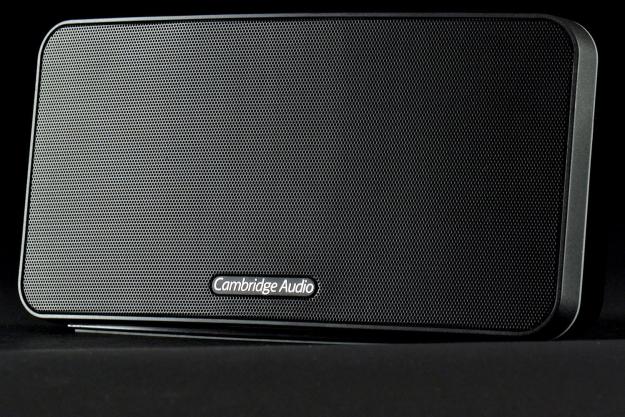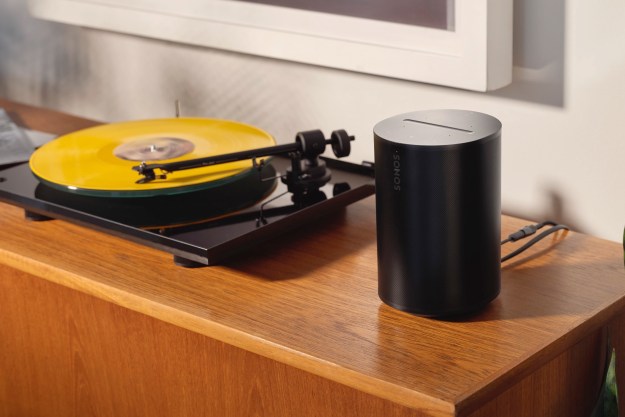
“Cambridge Audio’s Minx Go offered performance far beyond what we expect from a speaker in its price range.”
- Clear, detailed highs
- Powerful midrange and bass response
- High max volume without distortion
- Attractive design
- Good battery life
- Excessive Bluetooth signal noise
- Not particularly portable
London-based Cambridge Audio is classy. You can tell by the name – anytime you put Cambridge in a name, it automatically classes things up. But mostly it’s because of products like the Minx Go, an entry-level Bluetooth speaker that employs a decidedly British, no-nonsense design approach to create a succinct and refined rectangle of sound.
At $150, the Minx Go rides in decidedly dodgier circles than CA’s similarly styled Minx Air 100 and 200 Airplay speakers, which are priced around the $500 mark. Still, though the Go is much smaller and eschews Airplay, it does boast similar features to its cousins such as a class-D amplifier and Cambridge Audio’s proprietary DSP, and it adds the convenience of up to 18 hours of rechargeable battery life. Wondering what CA could offer at such a slim price point in one of the most competitive categories in audio, we fired the Minx Go up and set our ears to critical mode.
Out of the box
Our first impression of the Minx Go was that it looked expensive – our guess was about $200-250. Pulling the sleek, all-black device from its box, we discovered smooth lines of hard plastic, lacquered in a thick coat of black gloss. A slim border with a grainy, almost quartz texture ran along the front, outlining a handsome metal speaker screen. At the backside our fingers discovered a slim protective plate, riding atop a spongy, semi-exposed bass radiator.
The speaker’s base pad is all rubber, with a rotating fin at the center to keep the speaker on solid ground. The Go felt at once a bit big for a portable, and rather small for a homebound speaker, riding somewhere in the ether between the two.
Inside the box we also found a large cloth carrying case with a drawstring, an AC power adapter, and a tiny length of 3.5mm Aux cable.
Features and design
We’ve seen maybe 70-80 billion (give or take) entry-level Bluetooth speakers, and the Minx Go might be the most regally-styled device of the bunch. Its design is a lesson in simplicity, with a trio of dimpled keys across the top, including two volume keys and a power/pair button. The system fires up by holding down the power key, which emits a Blue LED, and pairing can be instigated by double pressing the key, though our smartphone paired automatically.
Our first impression of the Minx Go was that it looked expensive.
At the back left fender is a small input panel, harboring a USB charging port for smartphones, a 3.5mm Aux input, and the charging port. Beneath the surface, the speaker holds a quintet of drivers, including two ¾-inch titanium dome tweeters, dual two-inch ‘woofers’, and the rear-firing bass radiator plate at the back.
While the speaker’s 18 hour max battery life makes the Minx Go capable of travel, the open radiator and the overall size and design makes it feel a little fragile in the face of the elements, placing it in a different category than more heavily armored speakers like the Braven 600, or the JBL Charge. The Go also lacks a speakerphone, a standard feature on many models in its class. Still, convenience options aside, it’s also got a lot more hardware under the hood than most of its peers, potentially putting it ahead of the game sonically.
Performance
The first thing we noticed about the Minx Go is that, unfortunately, the speaker emitted a lot of noise when connected to our iPhone 5. While it varied as we listened on, it was pretty conspicuous and definitely clouded things a bit in the quieter moments of our evaluation. Still, for most of our session, music managed to mask the issue, and we reminded ourselves of the price point.
Once we adjusted to that unexpected wrinkle and began to engage with the sound, the speaker seemed to present itself a lot more like a Jazzer than a Rock ‘n’ Roller. If the Go was a fan at a concert, it’d be the guy in the nice suede jacket wearing bright orange ear plugs – and that’s cool with us. The speaker revealed a delicate, ribbon-y upper register, which it blended with a tight midrange, and some impressively thick low frequency potency thanks to the flexible little passive radiator at the rear.

We had equally enjoyable moments with our other pop pieces like Ben Fold’s “Losing Lisa”, and Dave Matthews’ “Rhyme and Reason.” And we were treated to a burst of rich potency when we called up the Muse track “City of Delusion.” The bass response was really on display here, with a nice punch of low-end depth in the toms and phase-y bass synth that rumbled through our coffee table. The speaker easily blasted out the full, multi-faceted zenith of the production without a hint of distortion, even at full volume. We also noticed some admirable stereo separation here, thanks to the speaker’s spread out front face.
…while hearty rock tracks weren’t the Go’s forte, they were still delivered with a great level of balance and presence…
When we switched gears to Neil Young’s “Walk On” from On the Beach we were actually pretty surprised at the Go’s ability to carve out the funky little flavors in the guitars, drawing out the rich crunch in the textures, while delivering excellent sustain in the cymbals and a satisfying punch to the crushed snare. The track seemed to glisten a bit, with more detail than we expect at this level, showing a good aptitude for acoustic music as well.
The limitations of the speaker’s tweeters were more readily exposed, however, when we pulled up rock numbers like “Street Fighting Man” by the Stones. The tacit delicacy of the upper register rendered the electric guitars with a wiry crunch, and the bass was wonky as the speaker seemed to be working overtime in the crinkly realm of the instrumental timbres.
That said, while hearty rock tracks weren’t the Go’s forte, they were still delivered with a great level of balance and presence, thanks in part to Cambridge Audio’s well-crafted DSP. And throughout our listening, we continued to be impressed with the wide swath of frequencies this little speaker was able to cover.
Conclusion
Apart from excessive noise in the wireless connection, Cambridge Audio’s Minx Go offered performance far beyond what we expect from a speaker in its price range. The Go’s gorgeous design, smooth and powerful sound signature, and impressive battery life makes it one of the best performers in the market under the $200 price point…and beyond. While it may not be the most travel friendly device of the bunch, those who appreciate good sound and design will definitely want to spend some time with the Minx Go.
Highs
- Clear, detailed highs
- Powerful midrange and bass response
- High max volume without distortion
- Attractive design
- Good battery life
Lows
- Excessive Bluetooth signal noise
- Not particularly portable
Editors' Recommendations
- Beats Solo 4: the latest on-ear headphones get spatial and lossless audio
- Cambridge Audio’s CXA81 Mk II amplifier gets a tune-up and a sweet new DAC
- Samsung Music Frame hands-on: invisible audio done right
- Next-gen wireless headphones will get lossless hi-res audio with a little help from Qualcomm
- Best wireless speakers for 2024: Sonos, JBL, KEF, and more






